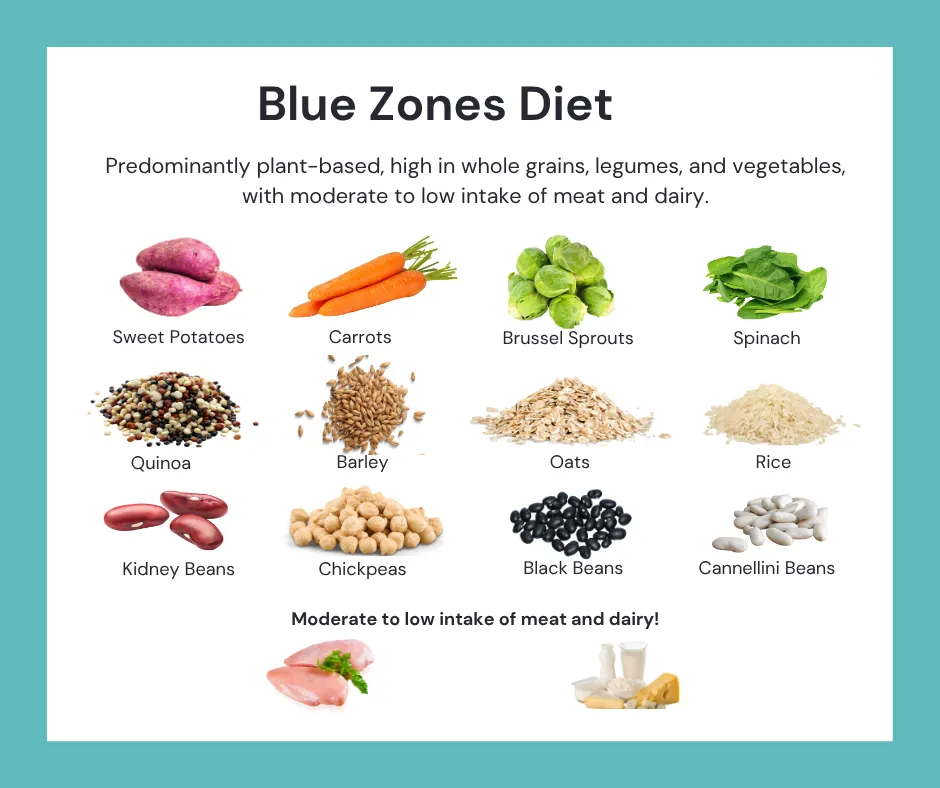
Blue Zones Diet: Eating Pattern Lifestyles For Longevity
Key Takeaways
Focuses on plant-based foods.
Rich in whole grains, legumes, and vegetables.
Low intake of meat and dairy.
Promotes longevity and health.
Easy to incorporate into daily life.
The Blue Zones Diet is an eating pattern inspired by the lifestyles of people in regions known for longevity. These areas are known as Blue Zones, including places like Sardinia, Okinawa, and Ikaria, where people live longer and healthier lives. By following a diet that's predominantly plant-based and rich in whole grains, legumes, and vegetables, you can boost your health and well-being.
Why Blue Zones?
In Blue Zones, people focus on eating foods that are minimally processed and packed with nutrients. Their diet is not only healthy but also sustainable. By reducing meat and dairy intake, they support environmental sustainability too.
Main Foods in the Blue Zones Diet
Let’s take a closer look at the main components of the Blue Zones Diet:
Sweet Potatoes: Loaded with vitamins and fiber, sweet potatoes are a staple food, especially in Okinawa.
Carrots: These colorful veggies are packed with beta-carotene, which is great for eye health.
Brussel Sprouts and Spinach: Green, leafy veggies are a rich source of vitamins A, C, and K.
Whole Grains like Quinoa, Barley, Oats, and Rice: These provide essential nutrients and are great for maintaining energy levels.
Legumes such as Kidney Beans, Chickpeas, Black Beans, and Cannellini Beans: High in protein and fiber, they make excellent meat substitutes.
Moderation with Meat and Dairy
While the diet mainly focuses on plant-based foods, it allows for moderate consumption of meat and dairy. Instead of making them the main part of meals, they serve as occasional treats or flavor enhancers. This approach helps reduce the risk of heart disease and other health issues.
Health Benefits
Eating a Blue Zones Diet can offer many health benefits, including:
Improved Heart Health: A diet rich in plants and low in saturated fats helps maintain a healthy heart.
Lower Risk of Chronic Diseases: Reduced intake of processed foods lowers the risk for diabetes and cancer.
Better Digestive Health: High fiber intake aids in digestion and prevents bloating.
Longevity: Focusing on nutrient-rich foods contributes to a longer, healthier life.
Tips for Starting the Blue Zones Diet
Here are some tips to help you get started with the Blue Zones Diet:
Replace refined grains with whole grains such as quinoa and barley.
Include a variety of vegetables in your meals every day.
Use beans and legumes as a protein source instead of meat.
Limit meat and dairy to a few times a week.
Experiment with new recipes that focus on plant-based ingredients.
Conclusion
Incorporating elements of the Blue Zones Diet into your life can be a positive step towards better health and longevity. By focusing on whole, plant-based foods and moderating meat and dairy intake, you'll be following a path known for its benefits to both personal and planetary health. Start small and gradually introduce more Blue Zones foods into your diet. Remember, making sustainable changes is key to a healthier lifestyle.